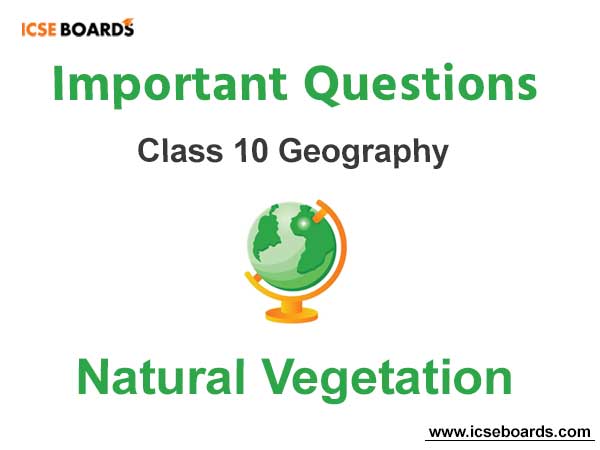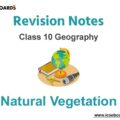Students of ICSE Class 10 should refer to Natural Vegetation ICSE Class 10 Geography Questions below which have come in past board exams. You should always go through questions that have come in previous years. This will help you to understand the pattern of questions in ICSE Class 10 Geography and prepare accordingly. This will help you to get better marks in ICSE Class 10 Board Exams
ICSE Class 10 Geography Natural Vegetation Important Questions
Students should learn the important questions and answers given below for Chapter Natural Vegetation in Geography for ICSE Class 10. These board questions are expected to come in the upcoming exams. Students of ICSE Class 10th should go through the Important questions and answers ICSE Class 10 Geography which will help them to get more marks in exams.
Board Exam Questions Natural Vegetation ICSE Class 10 Geography
Question. What is meant by natural vegetation?
Answer: Natural Vegetation refers to the plant cover that has not been disturbed over a long time, so as to allow its individual species to adjust themselves fully to the climate and soil conditions.
Question. Name any two trees that grow in the Tropical Deciduous Forests and provide timber.
Answer: Sal and teak grow in the Tropical Deciduous Forests and provide timber.
Question. What is Social Forestry?
Answer: Social Forestry refers to the management and protection of forests and af fo re stat i on on b arre n l ands wi th the pur po se o f he l p ing in t he environmental, social and rural development.
Question. What are the climatic conditions under which evergreen forests develop?
Answer: Evergreen forests are found in the areas where the amount of annual rainfall is more than 250 cm, average annual temperature is between 25°C and 27°C and average annual humidity exceeds 77 per cent.
Question. Under what climatic conditions do Montane Forests develop?
Answer: Montane forests are found in areas where annual temperature is 12ºC to 13ºC, rainfall is between 100 and 300 cm and annual humidity is between 56 and 65 per cent.
Question. Corridors must be established between different reserved forests. Why?
Answer: Corridors enable the migration of wild animals from one reserve to the other.
Question. Mention the areas where Tropical Desert Vegetation thrives.
Answer: Tropical Desert Vegetation forests are chiefly distributed in south-western Punjab, Haryana, Uttar Pradesh, central and eastern Rajasthan, Madhya Pradesh, Chhattisgarh, Gujarat, parts of Maharashtra, Karnataka and Andhra Pradesh. Littoral Forests are found in wet marshy areas, in river deltas, in tidal or other swampy areas and along the sea coasts.
Question. Mention two main characteristics of Tropical Rain Forests.
Answer: The main characteristic features of these forest are :
(i) They are dense, multi-layered and have many types of trees and shrubs.
(ii) Trees reach great heights of more than 60 m or above.
Question. Name two varieties of the Tropical Deciduous Forests.
Answer: Two varieties of the Tropical Deciduous Forests are :
(i) The Moist deciduous forests
(ii) The Dry deciduous forests
Question. Briefly explain two reasons for forests being an important natural resource.
Answer: (i) Forests are the moderators of climate. They play an effective role in controlling humidity, temperature and precipitation.
(ii) Forests play dominant role in carbon cycle. They absorb atmospheric carbon dioxide and help in maintaining the purity of air and controlling atmospheric pollution.
Question. Name the type of forests found in the western part of the Western Ghats. Give two reasons why these forests are so named. OR Why do Tropical Evergreen Forests appear green all the year round ?
Answer: Tropical Evergreen Forests are found in western part of Western Ghats.
Reason :
(i) Since these forest are restricted to heavy rainfall areas receiving more than 250 cm rain therefore these forests are dense, multi layered and
hence many types of trees and shurbs are found.
(ii) Trees of such forests do not have fixed time to shed their leaves, to flowers or for fruition. That is why these forests appear green all year round.
Question. Give any three features of social forestry.
Answer: (i) Restoration, reallocation, reorganisation of existing forest lands for the total development of the land and the people living on it.
(ii) Joint management of the forest and its production processes.
(iii) Developing the socio-economic structure that makes the above two possible.
Question. Why are deciduous forests commercially the most exploited ones?
Answer: (i) Deciduous forests have important trees such as sandalwood, teak, sal, shisham etc.
(ii) Beside, providing valuable timber, these provide various other products. Sandalwood, found in thse forests is in great demand in India & abroad.
(iii) Also these forest are less dense. So, deciduous forests are commercially the most exploited ones.
Question. What are the characteristic features of Littoral Forests?
Answer: The main characteristic features of Littoral forests (Tidal forests) are:
(i) They have mainly evergreen species of varying density and height, usually associated with wetness.
(ii) The tree trunks are supported by a number of stilt like roots which remain submerged under water during high tide and can be seen during low tide.
(iii) They have profuse growth with tangle of climbers, which is an adaptation for survival in soft and shifting mud.
Question. What are the objectives of agro-forestry?
Answer: (i) To reduce pressure on natural forests for obtaining timber as well as non-timber forest produce.
(ii) To check soil erosion and to maintain the natural fertility of the soil.
(iii) To maintain ecological balance along with proper utilisation of farm resources.
Question. Give characteristic features of Montane Forests.
Answer: (i) Montane forests contain mixed species of broad leafed evergreen trees and conifers. They also contain scrubs, creepers and ferns.
(ii) At the foothills of the Himalayas deciduous forests are found.
(iii) At an altitude of 1000 m to 2000 m there are the moist temperate forests.
(iv) In the hilly areas of West Bengal and Uttarakhand, evergreen broad leaf trees like chestnut and oak are found.
(v) Between the altitude of 1500m and 1750 m, coniferous trees like Chir pine is an important tree. At an altitude of 2250 m and 3000 m, blue pine and spruce are found.
(vi) At higher altitudes, alpine forest and pastures are found followed by mosses and lichens. Beyond the snowline no vegetation is found.
(vii) In the Peninsular regions, the area is only about 1500 m in height and vegetation varies from tropical to temperate forests.
Question. Mention three methods for the conservation and development of forests in India.
Answer: (i) Afforestation : Growing more trees in open and barren spaces.
(ii) Stopping Indiscriminate Felling of Trees: There should be a strict ban on felling of naturally growing trees. If a tree has to be cut, necessary permission has to be obtained. Besides, proper replacement of trees by planting saplings at least in the ratio of 1:10 (1 tree to 10 saplings) should be undertaken.
(iii) Establishing Corridors between Different Reserved Forests: Wide corridors should be established in different reserved forests to allow the migration of wild animals. This will also help numerous species of animals to use these corridors for their dispersal and migration.
(iv) Using Alternative Sources of Energy: In order to conserve forests, we must use non-conventional or renewable sources of energy, like solar energy, tidal energy, hydel energy, etc.
Question. Give any four objectives of social forestry.
Answer: (i) Providing fuel wood, fodder for cattle, timber and minor forest products to rural people.
(ii) Utilising the available land according to its productive capacity.
(iii) Developing local cottage industries by providing raw materials.
(iv) Providing efficient conservation of soil and water.
Question. Give characteristic features of Dry Deciduous Forests.
Answer: (i) Dry Deciduous forests thrive between moist deciduous forests (in the east) and tropical thorn forests (in the west).
(ii) On the wetter margins, these forests have a transition into moist deciduous, while on the drier margins they degrade into thorn forests.
(iii) In the Northern Indian plains and in the areas of higher rainfall in the Peninsular Plateau, these forests have open stretches in which teak and other trees are interspersed with patches of grass.
(iv) During the dry season, the trees in these forests shed their leaves completely and give the forests a look of a vast grassland with naked trees.
(v) The common trees of these forests are teak, tendu, sal, rosewood, amaltas, bel, khair, axlewood, etc.








